Lawn Watering Tips
Lawn watering is crucial in keeping the grass healthy throughout the year. Knowing the best time to water the lawn and selecting the appropriate irrigation methods will prevent excessive watering and encourage deep roots. Using it well, one will be able to maintain a balance between water conservation and the healthy greenness of the landscape, which is environmentally friendly and aesthetically pleasing.
Why Proper Lawn Watering Matters?
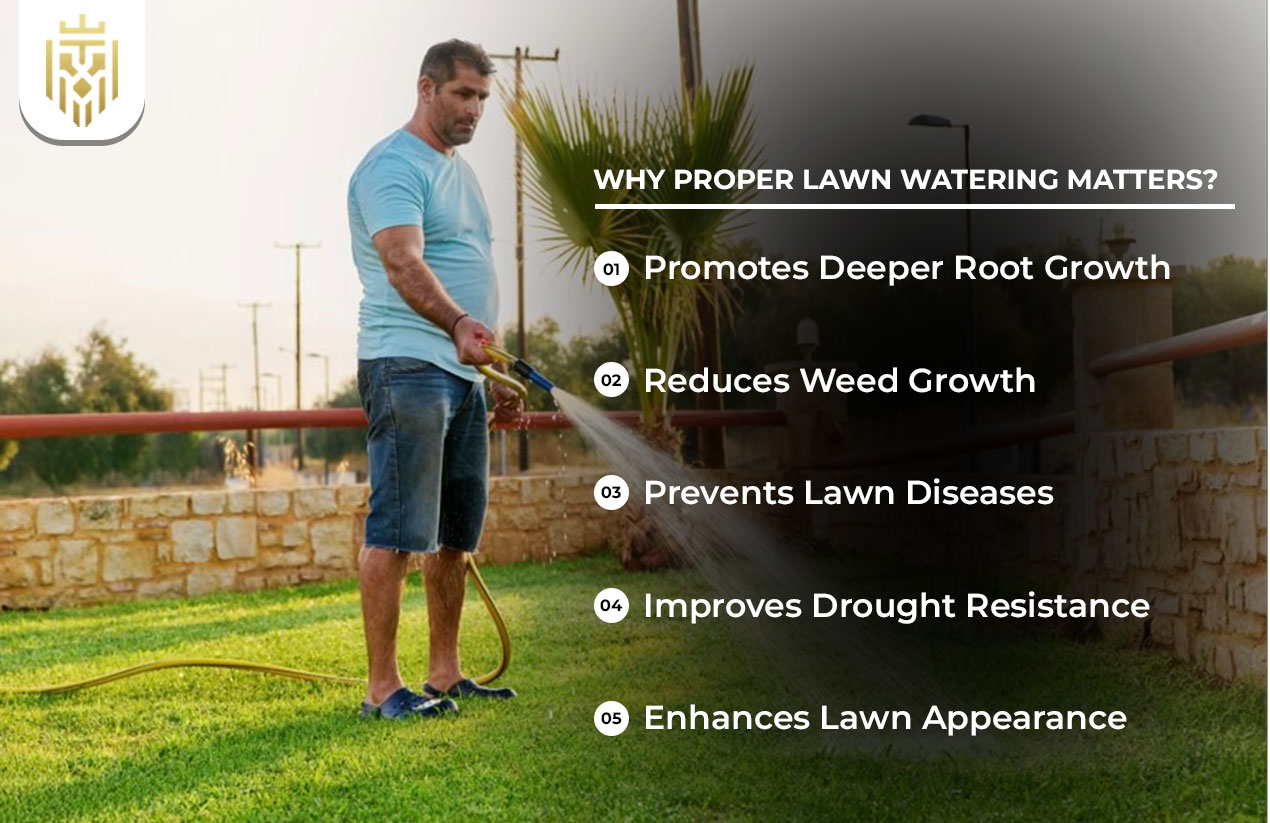
Effective lawn irrigation will provide your lawn with the appropriate amount of water and avoid wastage. Effective watering will encourage soil health, save resources, and ensure your lawn stays green even in dry months. Combining practices such as smart irrigation or rain harvesting will find the appropriate balance between sustainability and the longevity of the lawn.
Promotes Deeper Root Growth
When the grass is deeply watered, the roots grow downward so that the grass is drought-resistant. Efficient lawn watering will ensure that the soil is adequately wet without water oversaturation. Properly maintaining soil moisture levels means that your lawn will remain green longer and will need to be watered far less, keeping maintenance costs down with sustainability in fluctuating weather patterns.
Reduces Weed Growth
Proper watering makes the grass flourish with little space left for weeds. By deciding on morning lawn watering, the water penetrates deeply without lying on the surface. This inhibits the germination of weed seeds and assists in maintaining a healthy turf so that there is less need to use herbicides to maintain healthy and attractive lawns in the long term.
Prevents Lawn Diseases
Overwatering can lead to wet conditions, and this predisposes lawns to fungal diseases. Embracing smart irrigation systems assists in the management of water flow. There is no need to over-wet the soil since this provides sufficient hydration to the grass, thus safeguarding your lawn against prevalent diseases that flourish on overly saturated landscapes.
Improves Drought Resistance
A well-irrigated lawn develops drought resistance by training roots to tap into the deeper water. Even watering through a soaker hose is effective in distributing moisture. The practices help lessen the reliance on frequent irrigation as well as guarantee that your grass can handle prolonged dry periods without being worn out or losing its aesthetic appeal.
Enhances Lawn Appearance
Water directly affects the density and the color of the grass. Water conservation can be promoted by using a rain barrel to supplement watering without sacrificing beauty. Proper, consistent, and balanced watering will ensure a healthier and more attractive lawn that has long-term curb appeal with minimal strains on city water sources.
How Much Water Does a Lawn Need?
The amount of water required is determined by the climate, soil, and type of grass used. Understanding how often to water the lawn can be helpful to prevent over- or underwatering. The average lawn needs an inch or so of water per week, depending on the weather and the irrigation practice.
Factors That Influence Water Needs of Lawn
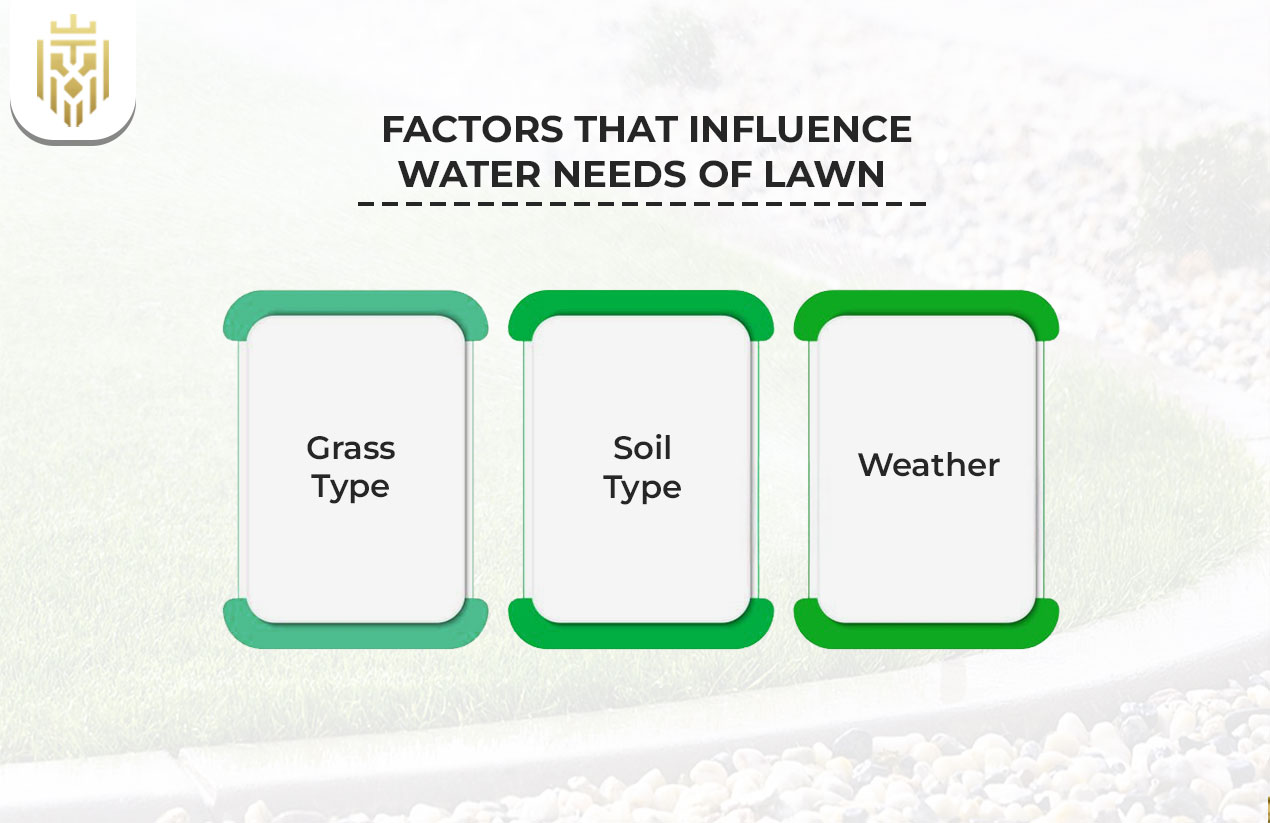
Various factors affect lawn hydration, such as lawn watering frequency, type of grass, nature of soil, and the climate of the area. The use of devices such as drip irrigation will assist in maximizing the use of water. Homeowners can manage schedules by measuring soil moisture, which allows lawns to thrive despite seasonal weather patterns and other environmental changes.
Grass Type
Grasses have varying water requirements. Warm-season grasses are more resistant to infrequent watering compared to cool-season grasses, which require frequent watering. Being aware of how often to water the lawn, depending on the type of grass, allows keeping the grass at the optimum level, avoiding excess watering of the lawn and wasting resources in variable spring-to-fall weather.
Soil Type
The composition of soil directly influences the retention of water. The sandy soil is prone to drainage, and watering is necessary more frequently than in clay-rich soil, which retains water. Even distribution can be achieved with a soaker hose. Soil moisture monitoring will support hydration in line with soil capacity, avoiding overwatering or lawn stress from water shortage.
Weather
The weather and climate have a significant influence on the duration of watering lawns. Hot, windy, or dry weather requires greater consumption of water, whereas rainy weather requires less. A rain barrel can aid in sustainable water conservation, whereby lawns can be kept healthy without depending entirely on the municipal water supply system during arid weather.
Best Time to Water Your Lawn
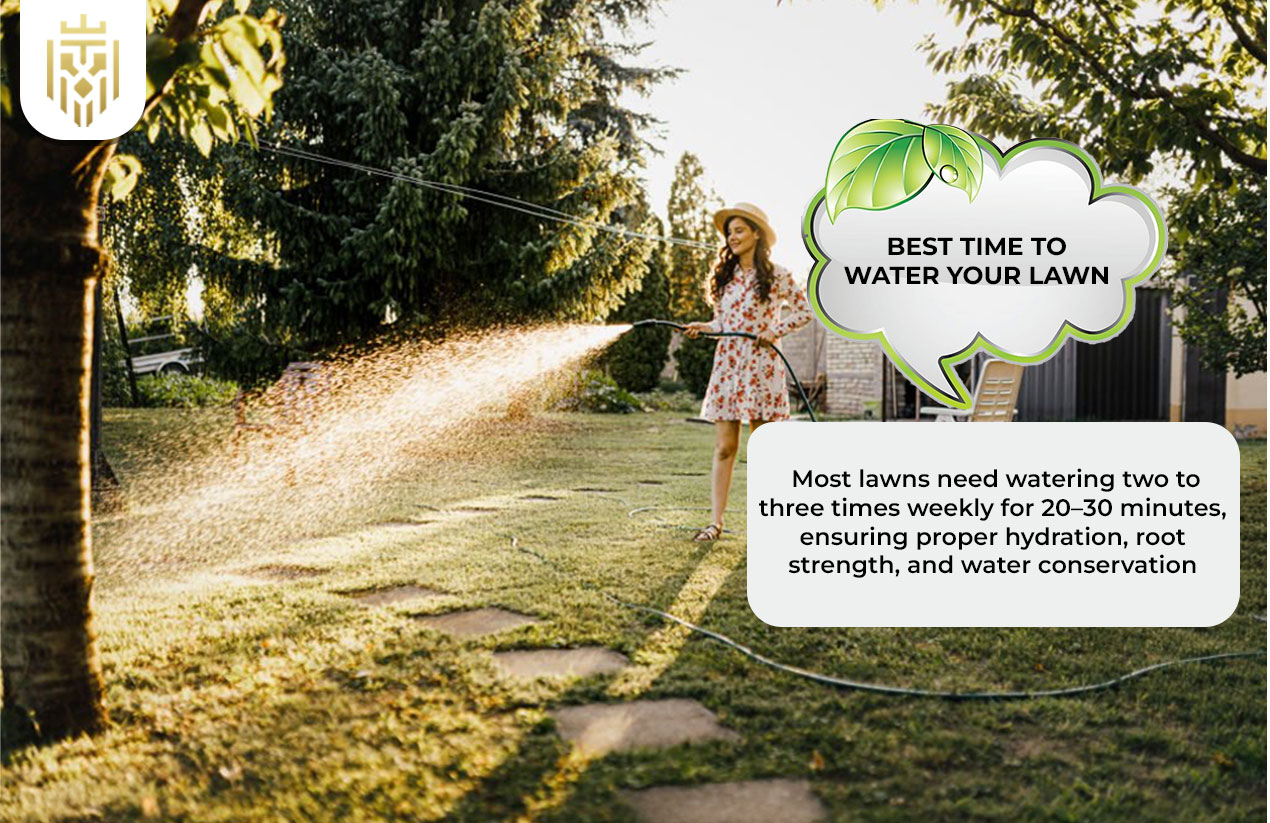
The best time to water a lawn is early in the morning at cooler temperatures and lighter winds. This enables water to penetrate deep into the soil. Effective lawn irrigation will guarantee that a lawn receives as much water as possible and will save water during the growing season.
Lawn Watering Frequency
Most lawns grow best when watered two to three times a week, depending on the soil and weather. The incorporation of drip irrigation will ensure reliable watering without wasting water. The frequency of watering the lawn is a fundamental issue in maintaining healthy grass growth and prolonged water conservation efforts.
Lawn Watering Duration
The system type and soil capacity determine the lengths of lawn watering. Most areas only require 20-30 minutes of watering per zone. With the knowledge of the time required to water the lawn, one will be able to guarantee that the grass is receiving one inch of water every week, and the water system can develop the roots properly without causing run-offs or shallow absorption issues.
Lawn Watering Methods
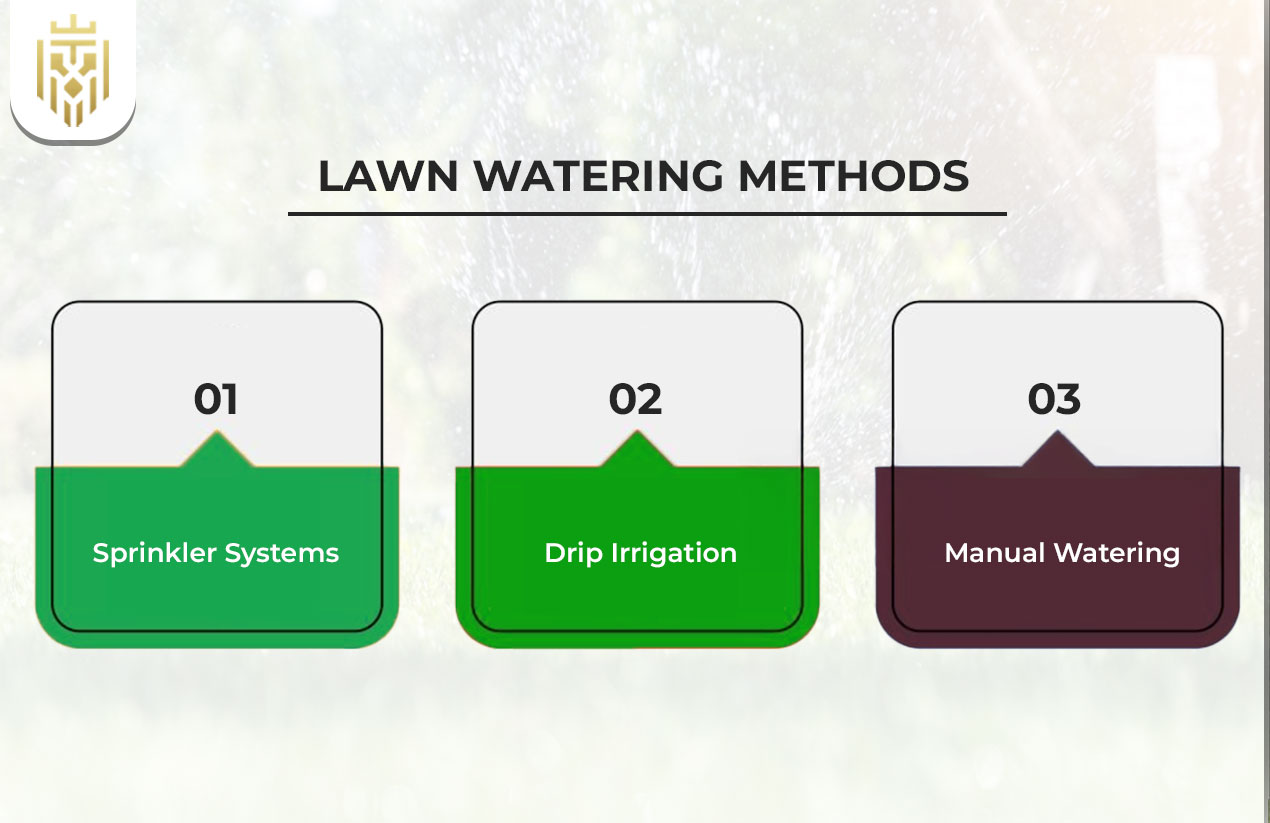
The selection of a watering system affects efficiency and lawn health. Each of these has its advantages: sprinklers, hoses, or drip irrigation. Even more efficient lawn irrigation is achieved using modern smart irrigation systems that automate the flow to keep lawns watered with minimal waste and maximum sustainability.
Sprinkler Systems
Sprinklers are common where lawns are large and require even watering. But modification is necessary to reduce the runoff in the area to save water. When sprinklers are combined with soil moisture monitoring, lawns become hydrated without the risks of poor maintenance and excessive watering, and the grass can remain healthy, all while maximizing the efficiency of water consumption throughout the year.
Drip Irrigation
Drip irrigation gets water into the roots directly, lessening evaporation and runoff. The technique can be beneficial in precision irrigation and can aid in sustainable lawn management. When combined with fall collection through a rain barrel, you have an eco-friendly lawn watering protocol that not only uses less water but also produces lush, well-cared-for grass every day of the year.
Manual Watering
Manual watering is flexible and allows homeowners to make adjustments according to the weather. Slow, even distribution is best achieved with a soaker hose. Although the approach is more demanding in terms of attention, it will enable accurate lawn watering schedules, and it is best used in small spaces or spot treatments where the grass needs special attention.
Professional Lawn Watering Tips
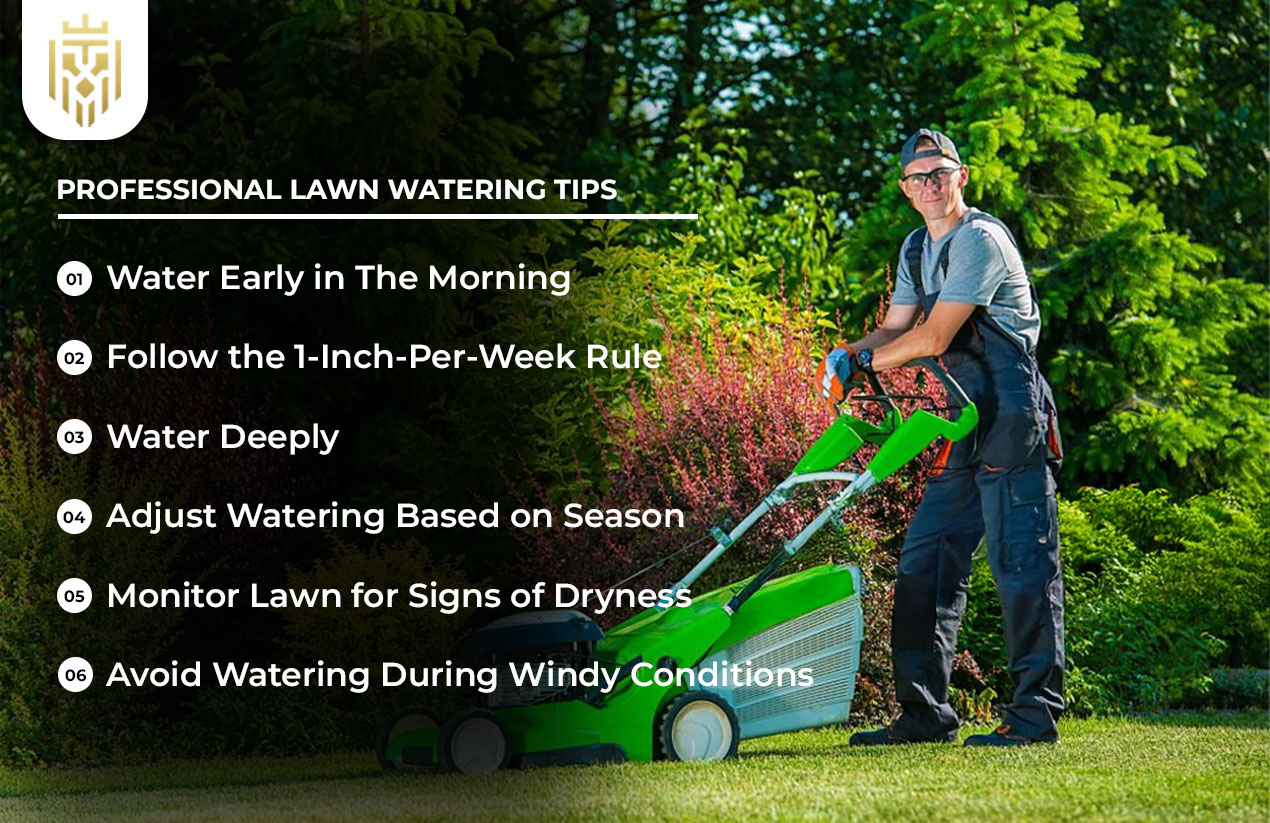
Good hydration can be achieved by adopting professional techniques. Learning about the duration of watering the lawn and the time of watering minimizes wastage. A combination of smart irrigation or conventional strategies, such as drip irrigation, will allow homeowners to have strong lawns and, at the same time, engage in sound water preservation techniques regularly.
Morning Watering
Watering early minimizes evaporation and fungal complications. Watering of lawns in the morning enables the grass to dry up fast, reducing disease transmission. When coupled with proper lawn watering systems, this will enhance absorption, enhancing turf health and ensuring that homeowners use water optimally without overutilizing it.
1-Inch Weekly Rule
Professionals suggest an inch of water per week. By utilizing a rain barrel, it is possible to monitor supply and conserve water. Together with the soil moisture monitoring, this recommendation can keep your grass well-hydrated but not over-saturated and keep your lawns lush, green, and environmentally sustainable all year round.
Deep Watering
Deep watering encourages root growth and lasting drought tolerance. Instead of spraying, placing a soaker hose or drip irrigation can provide the same amount of moisture consistently under the ground. This approach promotes healthier lawns and reduced watering, which contributes to efficient lawn watering activities and better environmental sustainability of residential landscapes.
Seasonal Watering Adjustments
Flexible watering plans are needed to address seasonal variation. Cooler months may need less frequent lawn watering, and summer may need more. Scheduling accordingly eliminates drought stress as well as overwatering. Smart irrigation systems help automate seasonal adjustments and can keep the lawn healthy with minimal human input.
Monitor Lawn Dryness
Grass color and texture can be used to determine how frequently to water. Symptoms such as wilting or fading show that soil moisture is low. Semi-regular evaluation of lawns minimizes the use of guesses and makes hydration specific, which encourages nutritious growth and helps to maintain sustainable lawn irrigation methods.
Avoid Windy Watering
Watering during windy weather is a waste of resources because most of the water gets evaporated before it gets to the roots. The lawn watering should be done when it is calm to facilitate absorption. When this is coupled with effective lawn watering systems, you are keeping the lawn healthy but avoiding the waste that is unnecessary, safeguarding your lawn as well as precious water resources.
FAQs
1) What is the best time to water your lawn?
Early morning is the most appropriate time to water the lawn because the temperatures are lower, the winds are calm, and water can penetrate deep into the soil, thus being very easily absorbed, making the evaporation rates low, and the chances of diseases are also low.
2) How often should you water your lawn?
Typically, lawns are watered two to three times a week, or more in some cases, depending on soil type, grass species, and climate. Knowing the frequency of watering the lawn promotes uniform watering, healthy roots, and proper water-saving measures.
3) How long should you water your lawn each time?
Watering 20-30 minutes each per zone is preferable. Properly watering your lawn so that it has roughly one inch per week can greatly benefit the growth of the roots and avoid runoff as well as a shallow foundation.
4) What factors influence a lawn’s water needs?
These factors, such as the water requirements of a lawn, vary according to the type of grass, soil, and weather. By monitoring the moisture in the soil and adjusting the irrigation of the lawn accordingly, watering is done more efficiently, with no stress, overhydration, or damage caused by drought.
5) What are the different lawn watering methods?
Popular lawn watering techniques consist of sprinklers to cover broad areas, drip watering to hydrate the root area, and soaker hoses to deep water the entire lawn. The appropriate method of lawn watering will help to use water efficiently and reduce its consumption.









